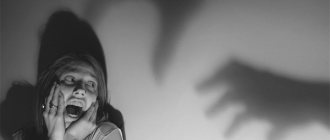What is schizophrenia?
Schizophrenia is a severe mental disorder (illness) that greatly affects a person's behavior, compromises lifestyle, debilitates daily activities, and leaves the patient unaware of what is real.
Initially, the disease presents with mild personality changes, mild paranoia and increased moodiness. It then develops into decreased emotional depression, noticeable personality changes, disorganization, "incoherent" speech, sudden mood swings, usually without any factors, and auditory hallucinations.
Tactile hallucinations are rare but may occur periodically. The patient often believes with a strong, almost to the point of stubborn, faith that what he perceives is real. The patient may become overly hostile, aggressive, withdrawn, or closed, depending on his mental status.
Epidemiology
Approximately 1% of the population of Russia, as well as throughout the world, suffer from this disease throughout their lives.
Age.
The disease usually begins between late adolescence and middle years of life (17-30 years). Schizophrenia is extremely rare in children under 15 years of age.
Floor.
Schizophrenia is diagnosed more often in men than in women (about 1.4:1). In addition, the onset of the disease occurs later in women than in men, possibly due to the antidopaminergic effect of estrogen in women.
Features in men
Men are more likely to have ideas of persecution, surveillance and espionage. Sometimes delusions and hallucinations are related to colleagues and work. If a paranoid schizophrenic has a partner, he will suspect his spouse of infidelity. In later stages, a man may try to protect himself from imaginary enemies. This is expressed in the creation of barricades, installation of additional locks, installation of video surveillance, etc.
Causes of male schizophrenia
Schizophrenia occurs both due to pathological processes occurring in the brain (gliosis, cancer, etc.) and as a result of childhood trauma, being victims of bullying, substance abuse or severe emotional trauma.
There are several main reasons:
- hereditary predisposition . A person receives an inherited set of chromosomes from two parents. Chromosomes store genetic information, so if someone in the family has this disease, then the likelihood of developing schizophrenia increases significantly. It can be transmitted not only from parents, but also from distant relatives and great-grandmothers;
- tendency to a pessimistic view of the world, chronic depression;
- environmental influence . Deviations in a man’s behavior can be noticed with frequent overwork, chronic insomnia, and abuse of alcohol and drugs;
- upbringing . Lack of love and care from the mother or support from the father can lead to the development of schizophrenia;
- age crises. Most often, the disease manifests itself in adolescence during a hormonal surge or when teenagers leave their parents' home and begin to live independently.
Often men do not show emotions and accumulate everything within themselves, solving the problem with alcohol or soft drugs, and that is why their incidence rate is higher than that of women. The behavior of men can also cause illness.
Revealing
Laboratory diagnostics can only determine changes in some areas of the brain when performing an encephalogram. They clearly show disturbances in brain activity.
Also, patients with schizophrenia experience a decline in conductive impulses that should be present in the brain.
Violations can be discovered completely by accident, during any diagnosis not related to the disease. If we talk about this procedure as part of a medical examination, then the average age of patients can be considered to be 25-35 years.
Thus, it is possible to diagnose the disease both in the absence of symptoms and in a condition where signs of schizophrenia are clearly visible in 30-year-old men.
How does schizophrenia manifest in men?
Unlike women's, men's schizophrenia is chronic and cannot be treated. To identify symptoms of schizophrenia, you need to look closely at a man’s behavior. Most often, they are not characterized by adequate behavior .
Patients are characterized by previously uncommitted actions and statements. For example, if a man was previously jealous of his girlfriend, now he will be callous and cold; if he used to happily help his mother with household chores, now he only thinks about himself. Meanwhile, relatives are trying to come up with excuses for his actions, for example, fatigue or problems at work. The extrovert becomes an introvert and becomes increasingly isolated from society.
The first signs of male schizophrenia
The first symptoms of schizophrenia are divided into several types.
Positive:
- hallucinations;
- delusional ideas;
- sloppiness;
- aggression;
- anxiety;
- thought disorders;
- motor disorders.
Negative:
- apathy;
- isolation;
- loss of interest in previously favorite activities;
- monotony of speech;
- weakness;
- lack of communication skills;
- speech dysfunction;
- mood swings.
Types and characteristics of the disease
There are several options for the development of schizophrenia, which differ in clinical picture and duration. There is a classification that helps specialists determine the form of schizophrenia:
- The continuous course is characterized by a slow increase with involution of mental abilities. Emissions are not expressed. The patient becomes withdrawn over time. The man's behavior is characterized by inadequacy.
- A sluggish disease is characterized by the manifestation of synesthesia (a special way of sensory experience) and the appearance of phobias. Hysteria is typical in the early stages. There are three periods: latent, or hidden, active, and the period of regulation, or stabilization.
- The severe course begins at an early age (adolescence). Characterized by emotional burnout, that is, the absence of any positive or negative emotions. Guys may complain of frequent headaches and incoherent thoughts. His attitude towards his family is deteriorating: he treats his mother like a tyrant and is rude to his father. In relationships with brothers or sisters he is callous and selfish.
- Paranoid schizophrenia. Characterized by the onset mainly after 25 years. The manifestations of the disease are characterized by panic attacks and inexplicable anxiety for one’s life. The patient stops trusting people, suspiciousness and isolation appear, which is quite difficult to explain. When a man has schizophrenia, any thought he expresses is considered genius, while those around him recognize it as nonsense. Visual hallucinations are characteristic.
Classification by attacks
If we talk about the age of the patient, then the signs of schizophrenia in men, whose behavior is clearly different from the life of a normal person, differ little on the age scale. Psychiatrists note mainly the types of illness, regardless of how old the patient is. Although there is evidence that at a later age the signs are smoothed out, that is, they are not very pronounced.
Schizophrenia is divided into the following types based on the strength and frequency of attacks:
- Continuously flowing.
- Paroxysmal-progressive.
- Recurrent.
- Sluggish. This form partially relates to schizophrenia itself and is called schizotypal disorder.
Types of disease and their symptoms
The following types of schizophrenia exist:
- Catatonic . Appears by the age of 20-30. Characteristic is full awareness of one’s actions when psychomotor disorders manifest. In the early stages, patients often consider themselves characters from fantasy stories. Any judgments, appeals and requests are ignored. There are problems with speech, sometimes men only respond to a whisper.
- The paranoid type is most common at the age of 30-40 years. It is characterized by delusions, self-rejection and various hallucinations. With this type, there is excessive aggressiveness, suspiciousness and irritability, as well as passivity.
- Hebephrenic schizophrenia . Difficult to treat. An adult begins to behave like a child, often fooling around. The patient loses his will and is emotionally unstable. There is a voice in my head that condemns the man’s actions. There is apathy.
- Simple type. Schizophrenia occurs in men of all ages. The main symptoms of schizophrenia are insensitivity, callousness and reluctance to engage in mental or physical activities. Patients avoid contact with people.
Features of manifestation at different ages
Signs of schizophrenia in men, behavior and frequency of attacks depend on age.
| Age category | Peculiarities |
| 14 – 30 years | Schizophrenia at a young age is difficult to treat and is considered the most difficult to diagnose. Possible symptoms:
Exacerbations of schizophrenia occur frequently |
| 30 – 50 years | The paranoid type of schizophrenia is most often diagnosed in this age group. This category of men is characterized by:
The frequency of relapses does not exceed 2-3 times a year |
| Over 50 years old | Psychiatrists note that schizophrenia cannot develop in old age; the onset of the disease is attributed to an earlier period. But there are several cases where this diagnosis was made to men after 50 years of age. Since at this age a person has a formed personality and certain life patterns, the symptoms of the disease are not clearly expressed:
It must be remembered that these signs, in combination with age, may relate to completely different diseases associated with the development of dementia. Exacerbations of the disease are practically not noticeable or are not diagnosed |
What examinations need to be completed?
The reason for the assumption of the disease is at least 2 symptoms of schizophrenia that appeared within six months.
In order to make a diagnosis of schizophrenia, it is first necessary to eliminate all kinds of therapeutic diseases. To do this, you need to make an appointment with a psychiatrist and neurologist. Specialists will conduct an examination to identify mental disorders.
It is also necessary to undergo such studies as:
- Magnetic resonance imaging;
- sleep monitoring;
- CT scan;
- study of the vascular system of the brain;
- conducting tests to identify mental disorders.
Indicators of laboratory tests are no different from tests of mentally healthy people. Often patients are hospitalized in order to observe behavioral reactions. The diagnosis of schizophrenia is made only after a complete examination of the patient.
Causes of the disease
Research into the causes of paranoid schizophrenia is ongoing, expanding the boundaries of understanding the essence of the disease.
The following theories are relevant:
- hereditary or genetic – leading, based on statistical data. Having an affected first-degree relative increases the incidence of the disease by 10%;
- neurochemical – patients necessarily have metabolic disorders of dopamine, kynurenic acid, serotonin, some proteins and other substances;
- long-term alcoholism and drug addiction, smoking mixtures or spices are especially dangerous in this sense, causing schizoid-like psychoses after the first use;
- abuse in childhood, abandonment, it does not matter whether this happened in a natural or adoptive family;
- maternal illnesses during pregnancy, especially intrauterine infections;
- oxygen starvation of the fetus or nutritional deficiency, when the newborn does not receive enough nutrients.
Treatment methods for schizophrenia in men
The hardest thing is to convince a man that he is really sick.
To treat schizophrenia in men, a complex of medications and therapy with a psychotherapist is used. Treatment is based on eliminating the symptoms of schizophrenia, not the causes. Treating schizophrenia is quite difficult, but it is possible.
Antipsychotic drugs
The most commonly used antipsychotic medications are:
- Clozapine;
- Risperidone.
In order to minimize side effects, it is necessary to choose the right dose. For example, the drug Clozapine has the most effective effect on the symptoms of male schizophrenia, however, as a side effect it causes a decrease in the number of leukocytes in the blood. In the early stages of use, the immune system weakens and the body is unable to effectively fight viral diseases. Patients are forced to take tests for leukocytes once a month.
Risperidone, unlike clozapine , can cause weight gain and, at the same time, cholesterol or blood sugar levels. Hallucinations, aggressiveness and stupor disappear in the first 2 weeks after starting treatment, and delirium only after 1.5 months.
These antipsychotic drugs are very strong, so in the first days of taking the tablets, drowsiness and excessive fatigue, dizziness with a sudden change in body position and rapid heartbeat (cardiac tachycardia) are characteristic, and sometimes a skin rash appears.
Driving is contraindicated for patients. It is impossible to predict in advance how a particular patient will behave when taking pills.
Psychotherapy
Schizophrenia can also be treated through therapy with a psychotherapist; such therapy helps patients open up and become part of society again. The specialist helps patients communicate. It brings back the will and motivation to life.
Stages of development
The disease can be clearly and clearly recognized, to a greater extent, in middle age
It is impossible to diagnose sluggish schizophrenia in childhood or adolescence, since its signs are completely erased. As a rule, the disease manifests itself after 20 years. The development of a condition is determined by its main stages of development:
- Latent or hidden period. There are no obvious schizophrenic signs in its course.
- The period of active development of the disease. Signs of sluggish schizophrenia in men and women increase gradually, but confidently, and attacks begin.
- Stabilization period. Personal changes are consolidated and take root.
The clinical picture of the disease is represented by the following symptoms and features:
- the latent stage is usually long;
- symptoms change gradually;
- characteristic signs appear periodically, each time growing more and more (obsessive states, disturbances of self-awareness, overvalued ideas).
At the stage of the latent course of the disease, the patient not only has no noticeable signs, but may even experience career growth and success in the personal sphere. Minor mental disorders are not perceived by either the patient or his relatives as alarming signs.
When sluggish schizophrenia enters the active stage, attacks of inappropriate behavior begin, negative personality changes, delusional and obsessive ideas appear. Often outbreaks are associated with age-related changes. After the attack phase, a stable remission usually occurs.
Prevention and prognosis
It is necessary to prevent the disease in case of genetic predisposition and in case of exacerbation of symptoms.
Nowadays, the field of medical genetic counseling is developing, so to exclude the possibility of having a child with mental disorders, it is necessary to undergo an examination.
The results will help:
- assess the mental state of both partners;
- fully study the genetic map of future parents;
- determine the risk of having a sick child;
- if necessary, the doctor will help you make the right decision.
Secondary prevention involves preventing the recurrence of symptoms of the disease.
The main goal of tertiary prevention is to slow the progression of schizophrenia. To avoid relapse, therapy is carried out with a psychotherapist and medications are prescribed. It is necessary to convey to the man that schizophrenia needs to be treated.
Today we can say that most types of schizophrenia are treatable. Patients with schizophrenia are able to return to their previous lives thanks to modern pharmacological results and the development of new dosage forms. The main thing is to consult a doctor in time for help.
There are many cases where a patient got rid of a mental disorder after a long hospitalization.
Symptoms
There is paranoid schizophrenia with a continuous type of course and with an episodic course. In the first case, she always pursues the patient. When they occur sporadically, the symptoms fade away, but the most striking ones may persist. This course of the disease makes life slightly easier for the patient.
The main signs of paranoid type schizophrenia are manifestations of delusions with hallucinations. They can be expressed in different degrees and forms. Most often, with delusional thoughts, the patient thinks that he is being followed, his phone is being tapped, or his apartment is being watched.
Hallucinations can be mild and can be expressed in the appearance before the eyes of various geometric shapes, objects, animals or birds. More severe cases are characterized by changes in the size of things, seeing oneself or one's double and someone or something behind. Auditory hallucinations also often occur. The patient may receive advice or comments from non-existent voices. Sometimes they can order him to perform this or that action.
Along with this, other symptoms arise:
- anxiety;
- isolation;
- aggressiveness;
- irritability;
- religiosity;
- thinking disorders;
- constant fear;
- depressed mood;
- lack of willpower;
- suspicion;
- negative nature of emotions.
Symptoms of paranoid schizophrenia may vary from person to person. It depends on age and gender. Children develop delusional thoughts about poisoning, constant fear and fantasies of persecution. Teenagers are more likely to experience thoughts about physical disabilities, which leads to anorexia. Women with this disease usually believe that someone wants to harm their children or family. Symptoms and signs of paranoid schizophrenia in men include ideas about espionage, being pursued by enemies, having wives as lovers, or being unkind to colleagues.
Personality defects in illness tend to increase over time. The patient begins to develop negative symptoms that are almost irreversible. He talks to himself or imaginary people, begins to reason, uttering unrelated words, loses his ability to work, constantly sits or lies in one place. Sanity gradually disappears completely.
To summarize
Schizophrenia is a mental disorder characterized by many personality changes, the most striking of which are paranoia, characterized by severe delusional experiences and delusions of persecution, auditory and sometimes tactile hallucinations.
The disease is considered one of the most devastating and economically catastrophic medical disorders, assessed by the World Health Organization (WHO) as a global challenge of our time.
Schizophrenia occurs mainly in families, indicating a genetic predisposition. The disease affects a person's ability to think and rationalize.
Features, reasons
Paranoid is called paranoid schizophrenia, described in the ICD under code F20.0. It is a mental disorder characterized by the manifestation of delusions and hallucinations in the patient. Most often it seems to him that he is being pursued, he can talk with imaginary interlocutors. Along with this, other emotional or behavioral disturbances occur.
The disease usually develops when a person reaches 25-35 years of age. In older people it occurs much less frequently. Childhood can be a time when schizophrenia develops. Most often, a child first encounters it at the age of 10-12 years.
The main cause of the development of the disease is considered to be a physiological disorder in certain areas of the brain associated with dopamine metabolism. The second most common was a genetic predisposition to this disease. If a person suffers from this disease, then heredity can lead to its occurrence in children.
Other causes of schizophrenia:
- viral infections in a pregnant woman;
- increased amount of stress;
- psychological trauma in childhood;
- Alzheimer's disease;
- taking psychotropic drugs in adolescence;
- starvation of the fetus, lack of nutrition in the pregnant woman;
- bearing a fetus in old age;
- alcohol abuse, drug use.
People who have several factors in their lives that contribute to the development of schizophrenia are at risk. They are recommended to pay special attention to their health, as well as regular visits to the doctor.
The onset of schizophrenia may not be noticeable, and the gradual development of deviations in the psycho-emotional sphere is not initially perceived by loved ones as something serious.











